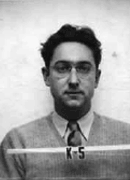Joseph W. Kennedy (1916-1957) was an American chemist.
In 1940 he co-discovered plutonium with Glenn Seaborg, Edwin McMillan, and Arthur Wahl. Kennedy built the instruments that proved the existence of plutonium. Kennedy, Seaborg, and Wahl also demonstrated that plutonium was fissile, which was key for Manhattan Project research. Room 307 in Gilman Hall at the University of California, Berkeley, where they worked, was designated a National Historic Landmark in 1966.
He was one of the first recruits to arrive at Los Alamos in March 1943, where he was selected to lead the chemistry and metallurgy division even though he was only 26 years old. Kennedy’s division was responsible for many important duties, including the purification of plutonium, the fabrication of plutonium and uranium metal, and the handling of polonium and radio-lanthanum.
After World War II, Kennedy joined the chemistry department of Washington University in St. Louis and eventually became the Chemistry Department head.
Seaborg and McMillan received the Nobel Prize in Chemistry in 1951 for “their discoveries in the chemistry of the first transuranium elements.” Kennedy received $400,000 from the Atomic Energy Commission in 1955 for his role in the discovery of plutonium.





